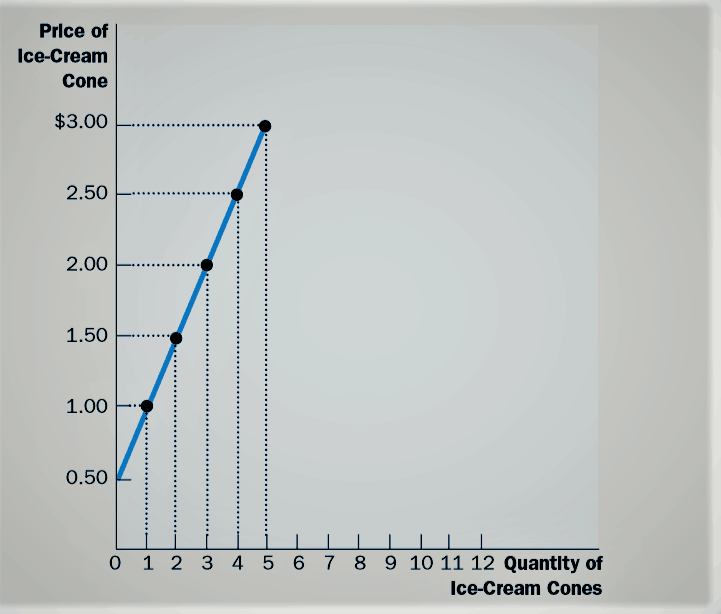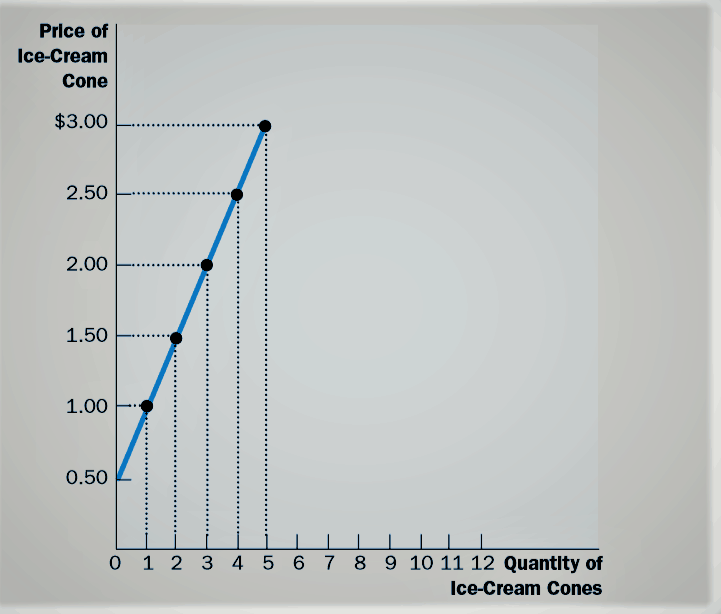Because the quantity supplied rises as the price rises and falls as the price falls, we say that the quantity supplied is positively related to the price of the good. This relationship between price and quantity supplied is called the law of supply.
Other things equal, when the price of good rises, the quantity supplied of the good also rises.
Table of contents
The chart below depicts the law of supply using a supply curve.
which is always upward sloping.

Each point on the curve reflects a direct correlation between the quantity supplied and price.
Supply Schedule
Consider how the quantity supplied varies with the price, holding input prices, technology, and expectations constant.
The table below shows the quantity supplied by Ben, an ice-cream seller, at various prices of ice cream.
| PRICE OF ICE-CREAM CONE | QUANTITY OF CONES SUPPLIED |
| $0.00 | 0 |
| $0.50 | 0 |
| $1 | 1 |
| $1.50 | 2 |
| $2.00 | 3 |
| $2.50 | 4 |
| $3.00 | 5 |
At a price below $1.00, Ben does not supply any ice cream at all. As the price rises, he supplies a greater and greater quantity. This table is called the supply schedule.
Supply Curve
A graph of the relationship between the price of a good and the quantity supplied is called a supply curve.
The graph below shows the relationship between the quantity of ice cream supplied and the price. The curve relating price and quantity supplied is called the supply curve.

The supply curve slopes upward because, ceteris paribus, a higher price means a greater quantity supplied.
Examples, Law of Supply
The law of supply sums up the effect price changes have on
For example, a business will produce more Ice Cream if the price of it increases.
The opposite is true if the ice cream decreases. The company might supply 100 containers if the price is $2 ice cream, but if the price increases to $3 they might supply 150 containers.
To further illustrate this concept, consider how fresh produce prices work. When the price of any vegetable rises, it encourages farmers to produce more of it and when the price of that vegetable decrease it demotivate farmers to grow that crop.
Factores drtermine supplies
Imagine that you are running Student Sweets, a company that produces and sells ice cream.
What determines the quantity of ice cream you are willing to produce and offer for sale?
Here are some possible answers.
01 Price
The price of ice cream is one determinant of the quantity supplied. When the price of ice cream is high, selling ice cream is profitable, and so the quantity supplied is large.
As a seller of ice cream, you work long hours, buy many ice cream machines, and hire many workers.
By contrast, when the price of ice cream is low, your business is less profitable, and so you will produce less ice cream.
At an even lower price, you may choose to go out of business altogether, and your quantity supplied falls to zero.
Because the quantity supplied rises as the price rises and falls as the price falls, we say that the quantity supplied is positively related to the price of the good.
This relationship between price and quantity supplied is called the law of supply: Other things equal, when the price of good rises, the quantity supplied of the good also rises.
02 Input Prices
To produce its output of ice cream, Student Sweets uses various inputs. such as cream, sugar, flavoring, ice-cream machines, the buildings in which the ice cream is made, and the labor of workers to mix the ingredients and operate the machines.
When the price of one or more of these inputs rises, producing ice cream is less profitable, and your firm supplies less ice cream.
If input prices rise substantially, you might shut down your firm and supply no ice cream at all.
Thus, the supply of a good is negatively related to the price of the inputs used to make the good.
03 Technology
The technology for turning the inputs into ice cream is yet another determinant of supply.
The invention of the mechanized ice-cream machine, for example, reduced the amount of labor necessary to make ice cream. By reducing firms’ costs, the advance in technology raised the supply of ice cream.
04 Expectations
The amount of ice cream you supply today may depend on your expectations of the future.
For example, if you expect the price of ice cream to rise in the future, you will put some of your current production into storage and supply less to the market today.
Mathematical Equation
In non-differentiable terms, the law of supply can be expressed as:
(p – p’) (y – y’) ≥ 0
where y is the amount that would be supplied at some price p, and y’ is the amount that would be supplied at some other price p
Thus for
